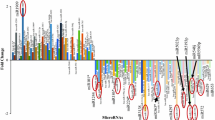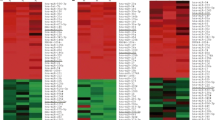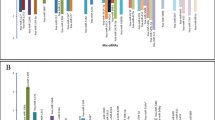Abstract
Purpose
Craniopharyngiomas are benign tumors of the sellar or parasellar regions. They arise from the remnants of Rathke’s pouch and are considered a “developmental disease.” microRNAs are short non-coding RNAs that play a key regulatory role in the control of expression of entire gene networks. We performed an extensive analysis of miRNAs in craniopharyngiomas aiming to identify a miRNA expression signature that might aid in the prognosis of disease progression and outcome.
Methods
Thirty-seven craniopharyngioma samples from twenty-three patients, ten age-matched controls from autopsy, and ten infant controls from the developing pituitary from autopsy were evaluated for the expression of 754 miRNAs using TaqMan® Low Density Arrays (TLDAs) v2.0 (Applied Biosystems, Foster City, CA).
Results
Among the most differentially expressed miRNAs, downregulation of miR-132 appears to be a marker of aggressiveness and also plays a role in epithelial–mesenchymal transition.
Conclusions
This is the first time that an extensive study of miRNA expression has been performed in craniopharyngiomas. Further research needs to be performed to investigate the potential role of miR-132 in the development and progression of craniopharyngiomas, and its value as a prognostic marker of aggressiveness.

Similar content being viewed by others
References
Karavitaki N, Cudlip S, Adams CB, Wass JA (2006) Craniopharyngiomas. Endocr Rev 27:371–397
Kelberman D, Rizzoti K, Lovell-Badge R, Robinson IC, Dattani MT (2009) Genetic regulation of pituitary gland development in human and mouse. Endocr Rev 30:790–829
Watkins-Chow DE, Camper SA (1998) How many homeobox genes does it take to make a pituitary gland? Trends Genet 14:284–290
Wang Y, Liang Y, Lu Q (2008) MicroRNA epigenetic alterations: predicting biomarkers and therapeutic targets in human diseases. Clin Genet 74:307–315
Ambros V (2004) The functions of animal microRNAs. Nature 431:350–355
Jansson MD, Lund AH (2012) MicroRNA and cancer. Mol Oncol 6:590–610
Croce CM (2009) Causes and consequences of microRNA dysregulation in cancer. Nat Rev Genet 10:704–714
Costa FF, Bischof JM, Vanin EF, Lulla RR, Wang M, Sredni ST, Rajaram V, Bonaldo Mde F, Wang D, Goldman S, Tomita T, Soares MB (2011) Identification of microRNAs as potential prognostic markers in ependymoma. PLoS One 6, e25114
Sredni ST, Bonaldo Mde F, Costa FF, Huang CC, Hamm CA, Rajaram V, Tomita T, Goldman S, Bischof JM, Soares MB (2010) Upregulation of mir-221 and mir-222 in atypical teratoid/rhabdoid tumors: potential therapeutic targets. Childs Nerv Syst 26:279–283
Sredni ST, Huang CC, Bonaldo Mde F, Tomita T (2011) MicroRNA expression profiling for molecular classification of pediatric brain tumors. Pediatr Blood Cancer 57:183–184
Campanini ML, Colli LM, Paixao BM, Cabral TP, Amaral FC, Machado HR, Neder LS, Saggioro F, Moreira AC, Antonini SR, de Castro M (2010) CTNNB1 gene mutations, pituitary transcription factors, and MicroRNA expression involvement in the pathogenesis of adamantinomatous craniopharyngiomas. Horm Cancer 1:187–196
Saeed AI, Bhagabati NK, Braisted JC, Liang W, Sharov V, Howe EA, Li J, Thiagarajan M, White JA, Quackenbush J (2006) TM4 microarray software suite. Methods Enzymol 411:134–193
Rittinger O, Kranzinger M, Jones R, Jones N (2003) Malignant astrocytoma arising 10 years after combined treatment of craniopharyngioma. J Pediatr Endocrinol Metab 16:97–101
Luu QT, Loredo LN, Archambeau JO, Yonemoto LT, Slater JM, Slater JD (2006) Fractionated proton radiation treatment for pediatric craniopharyngioma: preliminary report. Cancer J 12:155–159
Beckers A, Lodish MB, Trivellin G, Rostomyan L, Lee M, Faucz FR, Yuan B, Choong CS, Caberg JH, Verrua E, Naves LA, Cheetham TD, Young J, Lysy PA, Petrossians P, Cotterill A, Shah NS, Metzger D, Castermans E, Ambrosio MR, Villa C, Strebkova N, Mazerkina N, Gaillard S, Barra GB, Casulari LA, Neggers SJ, Salvatori R, Jaffrain-Rea ML, Zacharin M, Santamaria BL, Zacharieva S, Lim EM, Mantovani G, Zatelli MC, Collins MT, Bonneville JF, Quezado M, Chittiboina P, Oldfield EH, Bours V, Liu P, WdH W, Pellegata N, Lupski JR, Daly AF, Stratakis CA (2015) X-linked acrogigantism syndrome: clinical profile and therapeutic responses. Endocr Relat Cancer 22:353–367
Trivellin G, Daly AF, Faucz FR, Yuan B, Rostomyan L, Larco DO, Schernthaner-Reiter MH, Szarek E, Leal LF, Caberg JH, Castermans E, Villa C, Dimopoulos A, Chittiboina P, Xekouki P, Shah N, Metzger D, Lysy PA, Ferrante E, Strebkova N, Mazerkina N, Zatelli MC, Lodish M, Horvath A, de Alexandre RB, Manning AD, Levy I, Keil MF, Sierra Mde L, Palmeira L, Coppieters W, Georges M, Naves LA, Jamar M, Bours V, Wu TJ, Choong CS, Bertherat J, Chanson P, Kamenicky P, Farrell WE, Barlier A, Quezado M, Bjelobaba I, Stojilkovic SS, Wess J, Costanzi S, Liu P, Lupski JR, Beckers A, Stratakis CA (2014) Gigantism and acromegaly due to Xq26 microduplications and GPR101 mutation. N Engl J Med 371:2363–2374
Odenthal M, Hee J, Gockel I, Sisic L, Schmitz J, Stoecklein NH, Driemel C, Mohlendick B, Schmidt T, Knoefel WT, Lang H, Buttner R, Ott K, Vallbohmer D (2015) Serum microRNA profiles as prognostic/predictive markers in the multimodality therapy of locally advanced adenocarcinomas of the gastroesophageal junction. Int J Cancer 137:230–237
Della Vittoria Scarpati G, Falcetta F, Carlomagno C, Ubezio P, Marchini S, De Stefano A, Singh VK, D’Incalci M, De Placido S, Pepe S (2012) A specific miRNA signature correlates with complete pathological response to neoadjuvant chemoradiotherapy in locally advanced rectal cancer. Int J Radiat Oncol Biol Phys 83:1113–1119
Zhang X, Cheng J, Fu L, Li Q (2016) Overexpression of tissue microRNA10b may help predict glioma prognosis. J Clin Neurosci
Mao Y, Wu S, Zhao R, Deng Q (2016) MiR-205 promotes proliferation, migration and invasion of nasopharyngeal carcinoma cells by activation of AKT signalling. J Int Med Res 44:231–240
Wang N, Tao L, Zhong H, Zhao S, Yu Y, Yu B, Chen X, Gao J, Wang R (2016) miR-135b inhibits tumour metastasis in prostate cancer by targeting STAT6. Oncol Lett 11:543–550
Mirghasemi A, Taheriazam A, Karbasy SH, Torkaman A, Shakeri M, Yahaghi E, Mokarizadeh A (2015) Down-regulation of miR-133a and miR-539 are associated with unfavorable prognosis in patients suffering from osteosarcoma. Cancer Cell Int 15:86
Ma R, Zhang G, Wang H, Lv H, Fang F, Kang X (2012) Downregulation of miR-544 in tissue, but not in serum, is a novel biomarker of malignant transformation in glioma. Oncol Lett 4:1321–1324
Chen L, Zhang J, Feng Y, Li R, Sun X, Du W, Piao X, Wang H, Yang D, Sun Y, Li X, Jiang T, Kang C, Li Y, Jiang C (2012) MiR-410 regulates MET to influence the proliferation and invasion of glioma. Int J Biochem Cell Biol 44:1711–1717
Wang C, Liu P, Wu H, Cui P, Li Y, Liu Y, Liu Z, Gou S (2016) MicroRNA-323-3p inhibits cell invasion and metastasis in pancreatic ductal adenocarcinoma via direct suppression of SMAD2 and SMAD3. Oncotarget
Sun M, Huang F, Yu D, Zhang Y, Xu H, Zhang L, Li L, Dong L, Guo L, Wang S (2015) Autoregulatory loop between TGF-beta1/miR-411-5p/SPRY4 and MAPK pathway in rhabdomyosarcoma modulates proliferation and differentiation. Cell Death Dis 6, e1859
Liu H, Song Z, Liao D, Zhang T, Liu F, Zheng W, Luo K, Yang L (2015) miR-503 inhibits cell proliferation and invasion in glioma by targeting L1CAM. Int J Clin Exp Med 8:18441–18447
Ma N, Zhang W, Qiao C, Luo H, Zhang X, Liu D, Zang S, Zhang L, Bai J (2016) The tumor suppressive role of miRNA-509-5p by targeting FOXM1 in non-small cell lung cancer. Cell Physiol Biochem 38:1435–1446
Wu WJ, Shi J, Hu G, Yu X, Lu H, Yang ML, Liu B, Wu ZX (2015) Wnt/beta-catenin signaling inhibits FBXW7 expression by upregulation of microRNA-770 in hepatocellular carcinoma. Tumour Biol
Yao H, Liu X, Chen S, Xia W, Chen X (2015) Decreased expression of serum miR-424 correlates with poor prognosis of patients with hepatocellular carcinoma. Int J Clin Exp Pathol 8:14830–14835
Zhai Q, Zhou L, Zhao C, Wan J, Yu Z, Guo X, Qin J, Chen J, Lu R (2012) Identification of miR-508-3p and miR-509-3p that are associated with cell invasion and migration and involved in the apoptosis of renal cell carcinoma. Biochem Biophys Res Commun 419:621–626
Wu SL, Fu X, Huang J, Jia TT, Zong FY, Mu SR, Zhu H, Yan Y, Qiu S, Wu Q, Yan W, Peng Y, Chen J, Hui J (2015) Genome-wide analysis of YB-1-RNA interactions reveals a novel role of YB-1 in miRNA processing in glioblastoma multiforme. Nucleic Acids Res 43:8516–8528
Sun J, Feng X, Gao S, Xiao Z (2015) microRNA-338-3p functions as a tumor suppressor in human nonsmallcell lung carcinoma and targets Ras-related protein 14. Mol Med Rep 11:1400–1406
Xu Y, He J, Wang Y, Zhu X, Pan Q, Xie Q, Sun F (2015) miR-889 promotes proliferation of esophageal squamous cell carcinomas through DAB2IP. FEBS Lett 589:1127–1135
Cai J, Zhao J, Zhang N, Xu X, Li R, Yi Y, Fang L, Zhang L, Li M, Wu J, Zhang H (2015) MicroRNA-542-3p suppresses tumor cell invasion via targeting AKT pathway in human astrocytoma. J Biol Chem 290:24678–24688
Tombol Z, Eder K, Kovacs A, Szabo PM, Kulka J, Liko I, Zalatnai A, Racz G, Toth M, Patocs A, Falus A, Racz K, Igaz P (2010) MicroRNA expression profiling in benign (sporadic and hereditary) and recurring adrenal pheochromocytomas. Mod Pathol 23:1583–1595
Wu WR, Sun H, Zhang R, Yu XH, Shi XD, Zhu MS, Zeng H, Yan LX, Xu LB, Liu C (2016) Methylation-associated silencing of miR-200b facilitates human hepatocellular carcinoma progression by directly targeting BMI1. Oncotarget
Zhao J, Wang K, Liao Z, Li Y, Yang H, Chen C, Zhou YA, Tao Y, Guo M, Ren T, Xu L (2015) Promoter mutation of tumor suppressor microRNA-7 is associated with poor prognosis of lung cancer. Mol Clin Oncol 3:1329–1336
Kreth S, Limbeck E, Hinske LC, Schutz SV, Thon N, Hoefig K, Egensperger R, Kreth FW (2013) In human glioblastomas transcript elongation by alternative polyadenylation and miRNA targeting is a potent mechanism of MGMT silencing. Acta Neuropathol 125:671–681
Schopman NC, Heynen S, Haasnoot J, Berkhout B (2010) A miRNA-tRNA mix-up: tRNA origin of proposed miRNA. RNA Biol 7:573–576
Sand M, Skrygan M, Sand D, Georgas D, Gambichler T, Hahn SA, Altmeyer P, Bechara FG (2013) Comparative microarray analysis of microRNA expression profiles in primary cutaneous malignant melanoma, cutaneous malignant melanoma metastases, and benign melanocytic nevi. Cell Tissue Res 351:85–98
Burmester T, Weich B, Reinhardt S, Hankeln T (2000) A vertebrate globin expressed in the brain. Nature 407:520–523
Cazzoli R, Buttitta F, Di Nicola M, Malatesta S, Marchetti A, Rom WN, Pass HI (2013) microRNAs derived from circulating exosomes as noninvasive biomarkers for screening and diagnosing lung cancer. J Thoracic Oncol Off Publ Int Assoc Stud Lung Cancer 8:1156–1162
Althoff K, Lindner S, Odersky A, Mestdagh P, Beckers A, Karczewski S, Molenaar JJ, Bohrer A, Knauer S, Speleman F, Epple M, Kozlova D, Yoon S, Baek K, Vandesompele J, Eggert A, Schramm A, Schulte JH (2015) miR-542-3p exerts tumor suppressive functions in neuroblastoma by downregulating Survivin. Int J Cancer 136:1308–1320
Bray I, Tivnan A, Bryan K, Foley NH, Watters KM, Tracey L, Davidoff AM, Stallings RL (2011) MicroRNA-542-5p as a novel tumor suppressor in neuroblastoma. Cancer Lett 303:56–64
Xu L, Li M, Wang M, Yan D, Feng G, An G (2014) The expression of microRNA-375 in plasma and tissue is matched in human colorectal cancer. BMC Cancer 14:714
Yu X, Wu Y, Liu Y, Deng H, Shen Z, Xiao B, Guo J (2014) miR-21, miR-106b and miR-375 as novel potential biomarkers for laryngeal squamous cell carcinoma. Curr Pharm Biotechnol 15:503–508
Wu C, Li M, Hu C, Duan H (2014) Clinical significance of serum miR-223, miR-25 and miR-375 in patients with esophageal squamous cell carcinoma. Mol Biol Rep 41:1257–1266
Mayne GC, Hussey DJ, Watson DI (2013) MicroRNAs and esophageal cancer—implications for pathogenesis and therapy. Curr Pharm Des 19:1211–1226
Zhang N, Lin JK, Chen J, Liu XF, Liu JL, Luo HS, Li YQ, Cui S (2013) MicroRNA 375 mediates the signaling pathway of corticotropin-releasing factor (CRF) regulating pro-opiomelanocortin (POMC) expression by targeting mitogen-activated protein kinase 8. J Biol Chem 288:10361–10373
Melmed S (2015) Pituitary tumors. Endocrinol Metab Clin N Am 44:1–9
Renjie W, Haiqian L (2015) MiR-132, miR-15a and miR-16 synergistically inhibit pituitary tumor cell proliferation, invasion and migration by targeting Sox5. Cancer Lett 356:568–578
Zheng YB, Luo HP, Shi Q, Hao ZN, Ding Y, Wang QS, Li SB, Xiao GC, Tong SL (2014) miR-132 inhibits colorectal cancer invasion and metastasis via directly targeting ZEB2. World J Gastroenterol 20:6515–6522
You J, Li Y, Fang N, Liu B, Zu L, Chang R, Li X, Zhou Q (2014) miR-132 suppresses the migration and invasion of lung cancer cells via targeting the EMT regulator ZEB2. PLoS One 9, e91827
Diaz-Lopez A, Moreno-Bueno G, Cano A (2014) Role of microRNA in epithelial to mesenchymal transition and metastasis and clinical perspectives. Cancer Manag Res 6:205–216
Hao J, Zhang Y, Deng M, Ye R, Zhao S, Wang Y, Li J, Zhao Z (2014) MicroRNA control of epithelial-mesenchymal transition in cancer stem cells. Int J Cancer J Int du Cancer 135:1019–1027
Endo H, Muramatsu T, Furuta M, Uzawa N, Pimkhaokham A, Amagasa T, Inazawa J, Kozaki K (2013) Potential of tumor-suppressive miR-596 targeting LGALS3BP as a therapeutic agent in oral cancer. Carcinogenesis 34:560–569
Acknowledgments
The authors would like to acknowledge the significant contribution and dedication of Elio F. Vanin PhD who passed away right after completing the draft of this manuscript.
Author information
Authors and Affiliations
Corresponding author
Ethics declarations
Conflict of interest
The authors declare that they have no conflict of interest.
Funding
The Matthew Larson Foundation; Dr. Ralph and Marian C. Falk Medical Research Trust and the Maeve McNicholas Memorial Foundation.
Ethical standards
This study has been approved by the Ann and Robert H. Lurie Children’s Hospital of Chicago Institutional Review Board and had therefore been performed in accordance with the ethical standards laid down in the 1964 Declaration of Helsinki. All persons gave their informed consent prior to their inclusion in the study.
Additional information
In Memoriam of Elio F. Vanin
Jill Samis and Elio F. Vanin contributed equally to this work.
Rights and permissions
About this article
Cite this article
Samis, J., Vanin, E.F., Sredni, S.T. et al. Extensive miRNA expression analysis in craniopharyngiomas. Childs Nerv Syst 32, 1617–1624 (2016). https://doi.org/10.1007/s00381-016-3131-1
Received:
Accepted:
Published:
Issue Date:
DOI: https://doi.org/10.1007/s00381-016-3131-1




